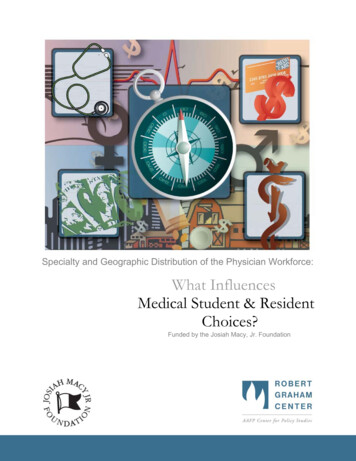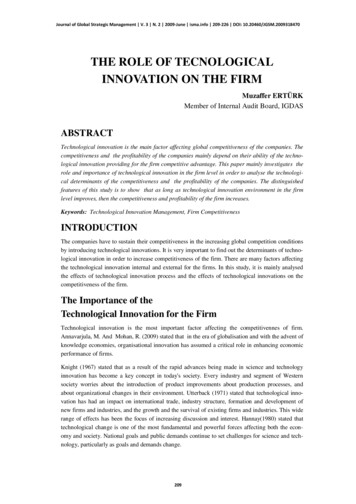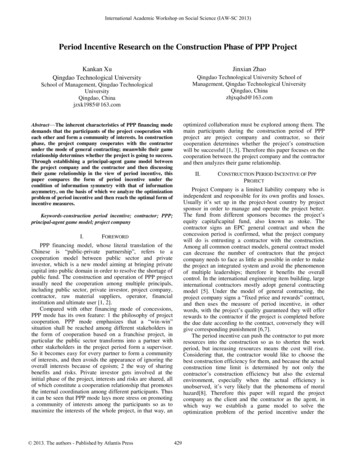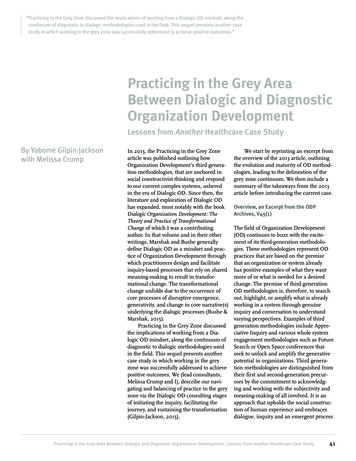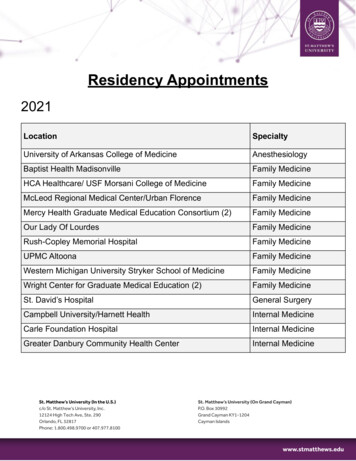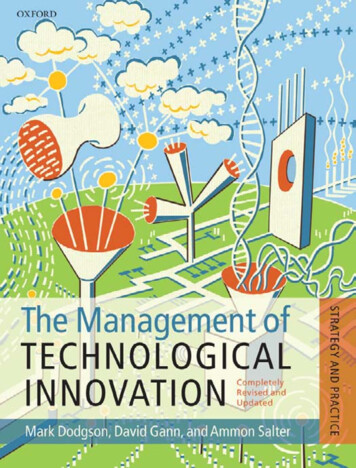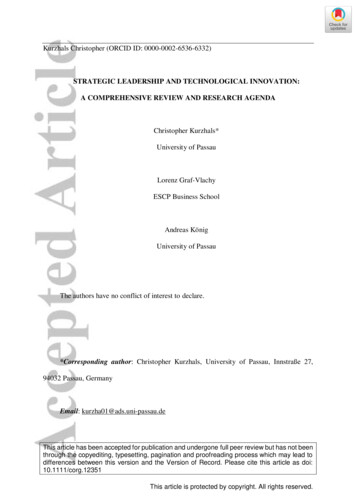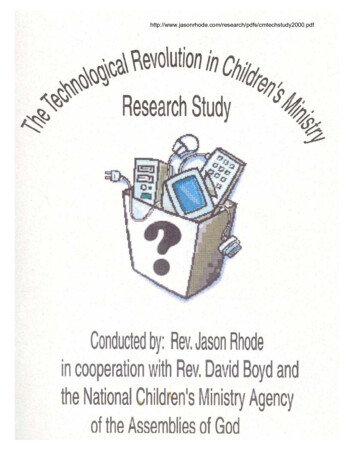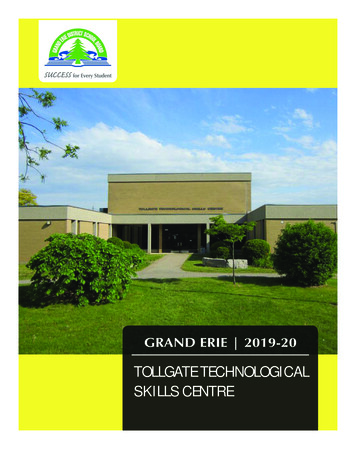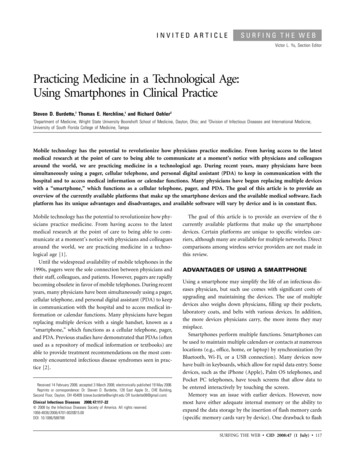
Transcription
INVITED ARTICLESURFING THE WEBVictor L. Yu, Section EditorPracticing Medicine in a Technological Age:Using Smartphones in Clinical PracticeSteven D. Burdette,1 Thomas E. Herchline,1 and Richard Oehler21Department of Medicine, Wright State University Boonshoft School of Medicine, Dayton, Ohio; and 2Division of Infectious Diseases and International Medicine,University of South Florida College of Medicine, TampaMobile technology has the potential to revolutionize how physicians practice medicine. From having access to the latestmedical research at the point of care to being able to communicate at a moment’s notice with physicians and colleaguesaround the world, we are practicing medicine in a technological age. During recent years, many physicians have beensimultaneously using a pager, cellular telephone, and personal digital assistant (PDA) to keep in communication with thehospital and to access medical information or calendar functions. Many physicians have begun replacing multiple deviceswith a “smartphone,” which functions as a cellular telephone, pager, and PDA. The goal of this article is to provide anoverview of the currently available platforms that make up the smartphone devices and the available medical software. Eachplatform has its unique advantages and disadvantages, and available software will vary by device and is in constant flux.Mobile technology has the potential to revolutionize how physicians practice medicine. From having access to the latestmedical research at the point of care to being able to communicate at a moment’s notice with physicians and colleaguesaround the world, we are practicing medicine in a technological age [1].Until the widespread availability of mobile telephones in the1990s, pagers were the sole connection between physicians andtheir staff, colleagues, and patients. However, pagers are rapidlybecoming obsolete in favor of mobile telephones. During recentyears, many physicians have been simultaneously using a pager,cellular telephone, and personal digital assistant (PDA) to keepin communication with the hospital and to access medical information or calendar functions. Many physicians have begunreplacing multiple devices with a single handset, known as a“smartphone,” which functions as a cellular telephone, pager,and PDA. Previous studies have demonstrated that PDAs (oftenused as a repository of medical information or textbooks) areable to provide treatment recommendations on the most commonly encountered infectious disease syndromes seen in practice [2].Received 14 February 2008; accepted 3 March 2008; electronically published 19 May 2008.Reprints or correspondence: Dr. Steven D. Burdette, 128 East Apple St., CHE Building,Second Floor, Dayton, OH 45409 (steve.burdette@wright.edu OR burdette08@gmail.com).Clinical Infectious Diseases 2008; 47:117–22 2008 by the Infectious Diseases Society of America. All rights reserved.1058-4838/2008/4701-0020 15.00DOI: 10.1086/588788The goal of this article is to provide an overview of the 6currently available platforms that make up the smartphonedevices. Certain platforms are unique to specific wireless carriers, although many are available for multiple networks. Directcomparisons among wireless service providers are not made inthis review.ADVANTAGES OF USING A SMARTPHONEUsing a smartphone may simplify the life of an infectious diseases physician, but such use comes with significant costs ofupgrading and maintaining the devices. The use of multipledevices also weighs down physicians, filling up their pockets,laboratory coats, and belts with various devices. In addition,the more devices physicians carry, the more items they maymisplace.Smartphones perform multiple functions. Smartphones canbe used to maintain multiple calendars or contacts at numerouslocations (e.g., office, home, or laptop) by synchronization (byBluetooth, Wi-Fi, or a USB connection). Many devices nowhave built-in keyboards, which allow for rapid data entry. Somedevices, such as the iPhone (Apple), Palm OS telephones, andPocket PC telephones, have touch screens that allow data tobe entered interactively by touching the screen.Memory was an issue with earlier devices. However, nowmost have either adequate internal memory or the ability toexpand the data storage by the insertion of flash memory cards(specific memory cards vary by device). One drawback to flashSURFING THE WEB CID 2008:47 (1 July) 117
memory is speed, because software installed to a flash memorycard may perform at a slower speed than programs that residein native memory. Therefore, users who want to install numerous programs should look for telephones with more available internal memory.Smartphones are able to function as 2-way pagers, allowingtext messaging and e-mailing to colleagues and family membersfrom anywhere in the world. If a physician is not available atthe time of a telephone call, most cellular telephones can function as pagers by receiving numerical text messages. Voice mailis a popular service for some physicians, although it requiressetup with the cellular carrier and can be prone to time lagand service quality issues.platform to allow easy review (figure 1). Windows Mobile 6.0devices are also prone to frequent “freezes,” when the devicewill become inactive for several minutes.SMARTPHONE OPERATING SYSTEMSAlthough they are distinctly different platforms, Windows Mobile 6.0 and Blackberry devices share similar features. Bothrequire data packages for online information retrieval and email communication. This platform gained a popular reputation because it was one of the earliest devices that was able to“go online” and access the internet and e-mail seamlessly. Builtin keyboards are standard to allow quick data entry and textmessaging. Blackberry telephones still lag somewhat in availability of medical software, although this is improving. Thehandset offers more advanced on-screen scrolling but lacks atouch screen.Six primary operating systems (OSs) are used by the cellulartelephone carriers. Each has its own unique features. What oneuser finds as an advantage to a particular format, another usermay find as a disadvantage. Before purchasing a new device,we recommend viewing table 1 and browsing online reviewsites (e.g., http://www.phonedog.com or http://reviews.cnet.com) to compare various devices and to review user experiences.WINDOWS MOBILE 6.0Windows Mobile 6.0 has the reputation of supporting strongcellular telephone features but at the expense of its PDA functionality. This OS is often confused with Windows Mobile 6.0for Pocket PC. The 2 OSs are distinct, and individual softwareapplications are not supported on both platforms (even thoughboth OSs are supported by Windows). The availability of medical software is limited but improving (table 2) in part becauseof a unique OS that was not previously popular in the medicalfield and that required different program coding to write software but also because of the small screen size and the lack ofa touch screen. Windows Mobile 6.0 telephones, in general, arephysically smaller than the other listed devices, except for Symbian telephones.Outlook synchronization is extremely reliable because ofWindows OS support. Many third-party personal informationmanagement systems exist that will upgrade the native software.However, synchronization of the memo pad with the built-inapplication is not available and requires third-party software ifa user is interested in this feature.Like the iPhone and Blackberry (Research in Motion), theplatform relies heavily on internet connectivity (via a data package from the service provider) for reference suites and othermedical applications. Such reliance will significantly increasethe costs of maintaining the device because monthly fees apply.Surfing the internet is not as seamless as with other devices.Web pages may not convert well to the Windows Mobile 6.0118 CID 2008:47 (1 July) SURFING THE WEBSYMBIANThe Symbian OS is an open OS designed for various companiesand requires unique network capabilities. Although the telephones are widely used, stand-alone medical software is muchmore limited than with any of the other devices. Of the othersmartphones listed in this review, the Symbian OS most closelycorresponds with the Windows Mobile 6.0 platform.BLACKBERRYPALM OSThe oldest and most stable of all of the platforms, the PalmOS (also known as the Palm Pilot or Treo) has been incorporated into several lines of smartphones to allow expandedaccess to programs and software. The Palm OS has perhapsthe largest number of medical applications of all of the smartphones, although there are still some medical software titlesnot supported by the Palm OS. There are multiple models,including the Treo line, but all are made by Palm Inc. and havesimilar designs. Each model has a built-in QWERTY thumbboard and a small high-resolution screen display ( 2.4 inchesin diagonal; 320 320 pixels). Navigation can be accomplishedthrough menus controlled by external buttons on the device.Navigation is also possible via a touch screen, generally withthe use of a stylus. Unlike non-smartphone Palm PDAs, it isimpossible to enter data directly through the touch screen withthe use of Graffiti. The newer models are Bluetooth capableand have infrared ports. They are not Wi-Fi capable. Installationof software does not require a data package, providing a significant cost advantage to many of the other devices.Voice quality for these telephones is generally rated as verygood. Palm OS–based telephones are often recommended forfirst-time users but probably have a learning curve similar toother smartphones. Individuals who have experience exclusively with Palm-based PDAs will generally prefer Palm OS–
Table 1.Comparison of MobileBattery capacityBluetooth Wi-FiInfrared port Data entry and retrievalDevice speed Device stabilityE-mail accessInternet browsingInfectious disease software Medical softwareScreen sizeSync with OutlookSync with Mac Text messagingWebsite viewingVoice mail VariableNOTE. , Good/limited availability; , excellent/universally availability; , poor/not available.aPlatform most similar to the Symbian OS.based smartphones. Palm-based devices will sync with eitherMac or Windows personal computers. Microsoft Outlook support is at times inconsistent and may require the installationof third-party software.POCKET PCMany different models of Pocket PC–based smartphones aremade by multiple manufacturers. As a result, far more choicesare available compared with other platforms. Because of thewidespread support of the Pocket PC platform, even Palm Inc.has released a Pocket PC–enabled Treo with a QWERTY thumbboard. However, the screen resolution is only 240 240 pixelson this telephone (compared with 320 320 for the Palm OS–based devices). Other models have a slide-out QWERTY keyboard and larger screen display ( 2.8 inches in diagonal;240 320 pixels). Navigation can be accomplished throughexternal button menus and via a touch screen, generally withthe use of a stylus. Most medical and personal applications areavailable for the Pocket PC platform. The block recognizer andletter recognizer use individual characters for text, number, andsymbol entries. The keyboard and symbol pad display characters that are selected with the stylus. The transcriber recognizes handwriting, including cursive writing. Because softwarecan be installed directly to the device, a data connection is notessential, providing a significant cost advantage to some of theother devices.Voice quality for these telephones is generally rated as verygood and has significantly improved with the latest models.Newer Pocket PC–based devices are generally more stable thanolder devices. Individuals who are most familiar with Windowsmay prefer Pocket PC–based smartphones. However, despitesimilarities in appearance, Pocket PC is not identical to Windows Mobile 6.0 and does not run the same versions of programsoftware. The Pocket PC OS requires third-party software towork with Mac personal computers, and there are issues indownloading some applications through a Mac computer to aPocket PC device. Pocket PC smartphones are designed to syncwith Microsoft Outlook and other e-mail software and are generally Bluetooth capable.IPHONEThe introduction of the iPhone was eagerly anticipated in 2007,with 1.4 million iPhones sold during the first 3 months afterintroduction [3]. Early users of the device were subject to activation glitches, premium pricing, and frequent software updates. Even so, customer surveys suggested an extremely highrate of satisfaction with the handset among its owners [4].For physicians, many of whom who were already using asmartphone, the iPhone platform brought with it severalunique features but at the expense of a few notable compromises. Highlights included a more fully integrated collection ofnative applications, such as the almost seamless transitionamong telephone, contacts, maps, e-mail, Short Messaging Service (SMS), and browser functions. A handheld version of theOS X browser Safari permitted access to full-sized Web pagesand could download and display complete Adobe portable docSURFING THE WEB CID 2008:47 (1 July) 119
Table 2.Software and Websites available for use on smartphones.Smartphone WebsitesaURLCompatible platforms supportedBlackberry berryCollective Medhttp://www.collectivemed.com/pdaBlackberry, Palm OS, Pocket PC, Windows MobileEpocrateshttp://www.epocrates.comBlackberry, Palm OS, Pocket PC, Windows MobileHandangohttp://www.handango.comBlackberry, Palm OS, Pocket PC, Windows MobileJohns Hopkins Antibiotic Guidehttp://hopkins-abxguide.orgBlackberry, Palm OS, Pocket PC, Windows MobileMedCalchttp://www.med-ia.ch/medcalc/Palm OS, Pocket PCMedical Pocket PChttp://www.medicalpocketpc.comBlackberry, Palm OS, Pocket PC, Windows MobileMerck ates/tier2/PDAtools.jspBlackberry, Palm OS, Pocket PCMicromedexhttp://www.micromedex.comPocket PC, Palm OSMobipockethttp://www.mobipocket.comBlackberry, Palm OS, Pocket PC, Windows MobileLexi-Comphttp://www.lexi.comBlackberry, Pocket PC, Palm OSPDA Medisofthttp://www.pdamedisoft.comBlackberry, Palm OS, Pocket PC, Windows MobilePDRhttp://www.pdr.netPalm OS, Pocket PCPepidhttp://www.pepid.comBlackberry, Palm OS, Pocket PC, Windows m OS, Pocket PCPocketgearhttp://www.pocketgear.comPalm OS, Pocket PC, Windows MobilePocket PC Blackberry, Palm OS, Pocket PC, Windows MobileQxMDhttp://qxmd.comBlackberrySanford Guidehttp://www.sanfordguide.comPalm OS, Pocket PCShots 2008http://www.immunizationed.orgBlackberry, Palm OS, Pocket PC, Windows MobileSkyscapehttp://www.skyscape.comBlackberry, Palm OS, Pocket PC, Windows MobileTarasconhttp://www.tarascon.comBlackberry, Palm OS, Pocket PCUnbound Medicinehttp://www.unboundmedicine.comBlackberry, Palm OS, Pocket PC, Windows MobileUpToDatehttp://www.uptodate.comPalm OS, Pocket PC, Windows MobileUSBMIShttp://www.USBMIS.comBlackberry, Palm OS, Pocket PCaThe iPhone does not yet support downloaded medical applications, although it can access many online resources via its internetbrowser. Data packages that provide internet access may allow software or Website access for nonsupported devices.ument format pages, a helpful feature for those who preferredaccessing the medical literature remotely. Possessing far moreintegrated flash memory (8/16 gigabytes) than any smartphonebefore it, the iPhone provides ample space to store contacts,schedule items, e-mails, and digital music and video files.Unlike its Palm and Windows Mobile–based predecessors,the iPhone platform emphasized connectivity—the potentialfor unlimited, instant access to applications and other resourcesvia its Wi-Fi (802.11) and Enhanced Data Rates for GlobalSystem for Mobile Communication (GSM) Evolution (EDGE)connections. To access a medical resource, physicians couldpoint to it with the Safari browser application, and with Web2.0 support, the program could be accessed via the wirelessconnection. Unlike the Palm and Windows mobile platforms,applications initially could not be directly downloaded to thedevice. According to Apple, support for third-party native applications has not been initially available out of concern fordevice and network security issues [5].Unfortunately, a device with as much Web integration as theiPhone is often at the mercy of its network connection. As aresult, internet-based medical applications often run moreslowly than similar native applications on Palm or WindowsMobile smartphones. Although less apparent in environmentswhere Wi-Fi is available, the EDGE network is noticeably120 CID 2008:47 (1 July) SURFING THE WEBslower. Compatibility with the much faster 3G standard is expected in the next version of the iPhone, due in mid-2008 [6],although first-generation telephones cannot be upgraded to thefaster network.Perhaps in response to growing feedback from its users, inlate 2007, Apple announced support for an iPhone softwaredeveloper’s kit [5]. First released in March 2008, this permitsthe development of third-party, downloadable applications tothe iPhone. With this added capability, many more medicalsoftware suites from established PDA platforms may add iPhone support, which is welcome news that may at last allowiPhone users to shed their pockets of a second Palm or Windows Mobile–based PDA.Several other unexpected iPhone features enhance overallfunctionality as medical information device. The YouTube application allows easy access to a growing number of medicaleducation videos that are available on the popular site (http://www.youtube.com). Many educational institutions are nowusing standard iPods as learning accessories [7] for reviewingdownloadable educational materials. With the inclusion of afully functional iPod, the iPhone can also permit access todownloaded audio and video continuing medical educationcontent without wireless access or the need to carry a separateMP3 player.
Figure 1. A, iPhone, portrait layout. B, iPhone, landscape layout. C, Pocket PC, viewed with Opera Mobile, zoom at 50%, landscape layout.D, Windows Mobile. E, Palm. F, Pocket PC, viewed with Opera Mobile, zoom at 50%, portrait layout.WEB BROWSERSHOPKINS ANTIBIOTIC GUIDEAs smartphones become more popular, there may be a transition from free-standing medical software (such as Epocratesor Hopkins Antibiotic Guide) to Web-based software. All available devices currently have the ability to view Web sites, withsome devices having a much better aesthetic appearance thanothers (figure 1). To optimize Web viewing, a separate browsermay be downloaded. One alternate browser is Opera (http://www.opera.com). This software is available in different versionsfor various telephones and makes Web site viewing much closerto the capability of the iPhone.The Hopkins Antibiotic Guide has been available for manyyears, mostly for the Palm OS. Originally designed for the PalmOS and Pocket PC 2003 platforms, it has recently been madeavailable through Skyscape (http://www.skyscape.com), expanding the available platforms. The guide has 3 main sections:syndromes, pathogens, and antibiotics. It provides clinicallyoriented, highlighted information regarding the diagnosis andmanagement of infectious disease syndromes and other usefulinformation, all the while not bogging down the user with toomuch information. One unique aspect of this software is the“author opinion” section. This section allows the user to selectvarious medications for a specific infection and receive theauthor’s comments on that selection of therapy.INFECTIOUS DISEASES AND MEDICALSOFTWAREOne advantage to using a smartphone over a regular cellulartelephone is the availability of stand-alone medical applications. Below is a brief discussion of a few commonly usedinfectious diseases programs that may help practicing physicians or fellows in training become more efficient in patientcare. Links to the programs and other software or referencesare available in table 2.EPOCRATESPerhaps the most commonly accessed medical software on asmartphone is a drug database. Many such databases are available, but Epocrates is perhaps the most commonly accessed.The free version provides access to the drug database, whereasthe subscription service allows access to numerous other medSURFING THE WEB CID 2008:47 (1 July) 121
ical resources. Currently available for most platforms, Epocratesis a drug database that provides a wealth of clinical information.Physicians are able to access dosing, adverse reactions, druginteractions, and basic pharmacologic information among withother information. One useful feature of this software is the“multi-check.” This option allows entry of 2–30 drugs withsubsequent scanning of the database for drug interactions. Results provide a list of drug-drug interactions and the nature ofthe reaction. Additional free programs are available within thissoftware package, and device support varies by platform. Infection Management, a resource edited by Dr. John Bartlett,provides information regarding medical conference highlights,clinical news, and Dr. Bartlett’s Digest. Epocrates also providescategory 1 mobile continuing medical education that can beobtained on the smartphone with certificates of completionsent via e-mail. See table 2 for other available drug databases.MEDICAL CALCULATORSeveral medical calculators are available for the smartphone. The2 most commonly used are MedMath (supported by Epocrates)and MedCalc. Both provide access to routinely used medicalequations, such as for determining creatinine clearance or idealbody weight. Both are free, but supported platforms vary.SANFORD GUIDEThe traditional paperback pocket infectious disease guide isalso available in an electronic format. The information providedelectronically is identical to the paperback manuals but doesallow for more frequent updates and will allow physicians tohave access to the infectious disease recommendations evenwhen away from the office. Users who are familiar with thepaperback product may find the electronic version more difficult to navigate.INFECTIOUS DISEASE PODCASTSPodcasts are becoming an increasingly useful means of reviewing educational video and audio content on the Web. Someinfectious disease–oriented educational sites (e.g., http://www.IDPodcasts.net) permit broadcasts of medical presentations tosmartphones with streaming audio and video playback capability. With the iPhone, content downloaded to a computermay also be transferred to the device and played back usingthe iPod feature.PATIENT BILLINGPatient billing using smartphones is feasible. Numerous proprietary programs are available for either a single or multiple platforms. Physicians need to check with their billing provider to122 CID 2008:47 (1 July) SURFING THE WEBdetermine availability. Billing via the smartphone is advantageousin that users have access to their patient database at all times,allowing access to previous diagnosis and clinical information.Advanced users may even be able to design their own databaseusing software such as HanDbase (http://www.ddhsoftware.com). When tracking patients on a personal device, Health Insurance Portability and Accountability Act policies must be followed and password protection is recommended.CONCLUSIONSSmartphones are a new tool that will allow physicians to become more efficient in their daily activities while providingclinically updated care to their patients. Users must considermany facets of a device before deciding which one to purchase.We recommend users consider the following: screen size, availability of medical software and likelihood of using software,monthly financial expenditures for cellular and internet access,devices that colleagues are using, and presence of a keyboardto permit faster data entry.It is a dynamic time for smartphones, with new devices beingreleased every month. As developers continue to push the envelope and produce better and faster devices, the power of thesmartphone will provide the potential ability to improve physician efficiency. For this to happen, physicians must be willingto accept the new technology, embrace it, and customize it tomeet their needs.AcknowledgmentsPotential conflicts of interest. S.D.B. is an Epocrates advocate receivingfree software but no financial compensation. R.O. is a shareholder in Apple.T.E.H.: no conflicts.References1. Burdette SD, Herchline TH, Richardson WS. Killing bugs at the bedside:a prospective hospital survey of how frequently personal digital assistantsprovide expert recommendations in the treatment of infectious diseases.Ann Clin Microbiol Antimicrob 2004; 3:22.2. Richardson WS, Burdette SD. Practice corner: taking evidence in hand.ACP J Club 2003; 138:A9.3. Apple’s shares soar on Chinese interest in iPhone. Available at: 14apple.html?refpasia. Accessed 14 November 2007.4. Baig EC. iPhone buyers have no regrets. Available at: 07-12-iphone N.htm. Accessed13 July 2007.5. Richtel M. Apple to open programming to outsiders. Available at: 18apple.html. Accessed 18 October 2007.6. Harrison C. Apple to unveil faster iPhone, AT&T’s Stephenson says.Available at: w&pidp20601103. Accessed 28 November 2007.7. Ipod in Education Web page. Available at: http://www.apple.com/education/products/ipod. Accessed 8 May 2008.
Victor L. Yu, Section Editor Practicing Medicine in a Technological Age: Using Smartphones in Clinical Practice Steven D. Burdette, 1Thomas E. Herchline, and Richard Oehler2 1Department of Medicine, Wright State University Boonshoft School of Medicine, Dayton, Ohio; and 2Division of Infectious Diseases and International Medicine,
